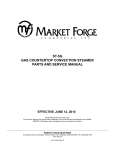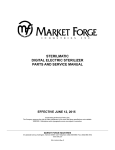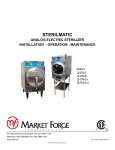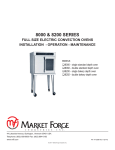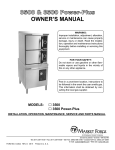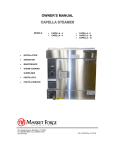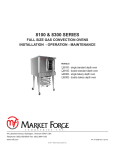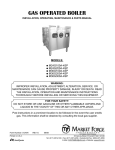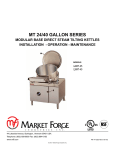Download Market Forge Industries FT-20CE Specifications
Transcript
FT-20CE ELECTRIC FLOOR MODEL TILTING KETTLES INSTALLATION - OPERATION - MAINTENANCE 44 Lakeside Avenue, Burlington, Vermont 05401 USA Telephone: (802) 658-6600 Fax: (802) 864-0183 www.mfii.com PN 14-0352 Rev A (9/14) © 2014 - Market Forge Industries Inc. Your Service Agency’s Address: Model Serial number Oven installed by Installation checked by TABLE OF CONTENTS IMPORTANT WARNING: Improper installation, adjustment, alternation, service or maintenance can cause property damage, injury or death. Read the installation, operation and maintenance instructions thoroughly before installing or servicing this equipment. FOR YOUR SAFETY Do not store or use gasoline or other flammable vapors or liquids in the vicinity of this or any other appliance. The information contained in this manual is important for the proper installation, use, and maintenance of this oven. Adherence to these procedures and instructions will result in satisfactory baking results and long, trouble free service. Please read this manual carefully and retain it for future reference. ERRORS: Descriptive, typographic or pictorial errors are subject to correction. Specifications are subject to change without notice. INSTALLATION Introduction.. . . . . . . . . . . . . . . . . . . . . . . . . . . . . . . . . . . . . . . . . . . . . . . . . . . . . . . . . . . . . . 2 Service Connections. . . . . . . . . . . . . . . . . . . . . . . . . . . . . . . . . . . . . . . . . . . . . . . . . . . . . . 3 Installation Instructions. . . . . . . . . . . . . . . . . . . . . . . . . . . . . . . . . . . . . . . . . . . . . . . . . . . . 4 OPERATION Operating Instructions. . . . . . . . . . . . . . . . . . . . . . . . . . . . . . . . . . . . . . . . . . . . . . . . . . . . . 5 MAINTENANCE Cleaning. . . . . . . . . . . . . . . . . . . . . . . . . . . . . . . . . . . . . . . . . . . . . . . . . . . . . . . . . . . . . . . . . 6 Introduction DESCRIPTION 3. Thermostat control closes to energize contactor coils. Model FT-20CE (20 gallon capacity) is an electrically powered, self-contained, tilting kettle. The appliance has a jacket of double-wall construction forming a sealed reservoir around the lower two-thirds of the kettle. The reservoir is charged with distilled water. Kettles are equipped with a “clean lock” to hold kettle in cooking position or 105 degrees for ease of cleaning, removable electric heating element and controls, and a low water cutoff device for protection of the heating elements. 4. Power is supplied to the elements through closed power contactors. 5. As the temperature of water rises in the kettle reservoir, increase in steam pressure is indicated on the pressure gauge. 6. When the temperature of steam in the reservoir reaches the setting shown on the temperature control dial, the temperature control opens to shut off the heating elements. The temperature control will cycle On/Off as required to maintain set temperature. BASIC FUNCTIONING Self-contained kettles operate by generating steam in the kettle reservoir. The sequence of operation is as follows: 1. Operator turns the power switch to the ON position and sets the temperature control dial at the desired setting from 1 to 10 (90 degrees Fahrenheit to 285 degrees Fahrenheit, 32 degrees Celsius to 140 degrees Celsius, jacket temperature). 2. Control circuit is normally completed to the temperature control if the following conditions exist: a. Water level in the kettle reservoir is adequate to prevent circuit interruption by the low water cutoff device. An activated cut-off is indicated by the amber low water light. b. Kettle is in vertical position with circuit completed through the tilt interlock switch. INSTALLATION 2 Service Connections ELECTRICAL CHARACTERISTICS MODEL pH FT-20CE 208V 230V 240V 380V 415V 480V kW Amp kW Amp kW Amp kW Amp kW Amp kW Amp 1 12 33.4 12 30.1 12 28.9 12 18.3 12 16.7 12 14.5 3 12 57.6 12 52.2 12 50.0 - - - - - - SERVICE CONNECTIONS EC Electrical Connection - to be as specified on data plate. ELECTRICAL CONNECTION EC RELIEF VALVE DIMENSIONS ARE IN INCHES [MM] 4 [102] FLANGED FOOT DETAIL 12.5 [318] 24 [610] 4 EQUALLY SPACED Ø7/16 [11] HOLES ON 3 [76] B.C. ELECTRICAL CONNECTION EC 30.75 [781] 21 [533] 18 [457] 30.25 [768] 43.5 [1105] 20.25 [514] 7 [178] 4.25 [108] 25 [635] Figure 1 3 INSTALLATION Installation Instructions 1. Select a location to provide drainage directly below the pour path of the kettle. Position appliance to allow sufficient rear clearance from wall to tilt freely and completely without obstruction. 2. Mark hole locations through flanged adjustable feet. Remove kettle. 3. On hole locations marked, drill holes and insert expansion shields to accommodate 5/16” size lag bolts. 4. Reposition kettle. Level kettle by making necessary adjustments on flanged feet. 5. Bolt down kettle and seal with Silastic or other equivalent sealing compound. Sealant must be applied not only to bolt heads but also around flanges making contact with floor surface to fulfill NSF International requirements. Wipe off excess sealant immediately. 6. A control box with power supply equivalent to electrical rating of kettle should be located conveniently nearby. 7. A waterproof electrical connection from power supply to rear of control housing must be provided. 8. Ground kettle to terminal provided inside control housing. 9. Turn power ON and check for proper operation. INSTALLATION 4 Operating Instructions TILTING INSTRUCTIONS 1. Ensure that the external electrical service to kettle is on. Your kettle has a standard “Clean Lock” feature and may not be tilted without disengaging the tilt knob located on the console at the top right. This feature locks the kettle in the upright position and also allows the operator to lock the kettle at 105 degrees for ease of cleaning. To tilt the kettle the full distance, the tilt lock knob must be disengaged from the cleaning position by pulling out the tilt lock knob and tilting the kettle forward the full distance. Follow these steps to tilt kettle: 2. Check pressure gauge for correct cold kettle reading. Reading should be in the green vacuum zone (25 - 30 In. Hg or 84 - 100 kPa of vacuum). If reading is not low enough, follow VENTING INSTRUCTIONS prior to using kettle. 3. Place power switch in ON position. 4. Preheat kettle by placing thermostat knob at ‘10’. Wait until TEMPERATURE light goes off. 1. Pull out the tilt knob at top right located on console. 2. Using kettle tilt handle pull kettle forward to desired angle of pour or until kettle locks at 105 degrees. The tilt knob can be released after the kettle has been tilted approximately 10°. NOTE: Preheating should not be used when cooking milk and egg food products which adhere to hot cooking surfaces. These foods should be placed into a cold kettle. 5. Add food to be cooked into kettle. 3. Kettle will lock in position at 105 degrees and may be tilted further by pulling the tilt lock knob a second time allowing the kettle to tilt the full distance. 6. Place thermostat knob at required temperature setting from 1 to 10 coinciding with a temperature range indicated by the table on the next page. 4. To return the kettle to the upright position, pull out the tilt lock knob and tilt the kettle upward until it locks in the upright position. The kettle should not move in either direction once in the upright position. Approximate cooking temperatures with water at various thermostat settings are as follows: THERMOSTAT SETTING APPROXIMATE (JACKET) TEMPERATURE °F °C 1 140° 60° 2 155° 68° 3 172° 78° 4 187° 86° 5 205° 96° 6 223° 106° 7 240° 116° 8 255° 124° 9 271° 133° 10 285° 140° 7. When cooking is finished, set thermostat knob and power switch to OFF position. 8. Pour finished product from kettle using tilt handle. Be careful to avoid splashing. 9. Add water to kettle for cleaning purposes. 10. Wash kettle thoroughly. See CLEANING INSTRUCTIONS. 5 OPERATION Cleaning clear water. Dry the surface completely and allow one hour before using the appliance to cook. WARNING Disconnect the power supply to the appliance before cleaning or servicing. Following daily and period maintenance procedures will prolong the life for your equipment. Climatic conditions salt air - may require more thorough and frequent cleaning or the life of the equipment could be adversely affected. WARNING Never spray water into electric controls or components! STAINLESS STEEL To remove normal dirt, grease or product residue from stainless steel, use ordinary soap and water (with or without detergent) applied with a sponge or cloth. Dry thoroughly with a clean cloth. Never use vinegar or any other corrosive cleaner. CAUTION The equipment and its parts are hot. Use care when operating, cleaning and servicing. CAUTION To remove grease and food splatters or condensed vapours that have baked on the equipment, apply cleanser to a damp cloth or sponge and rub cleanser on the metal in the direction of the polishing lines. Rubbing cleanser as gently as possible in the direction of the polished lines will not mar the finish of the stainless steel. NEVER RUB WITH A CIRCULAR MOTION. Do not use cleaning agents that are corrosive. Your kettle should be cleaned immediately after each use or when cooking a different product. Before cleaning, check that the kettle has cooled enough to touch it. 1. Rinse the inside of the kettle thoroughly and drain to remove any food particles. Soil and burn deposits which do not respond to the above procedure can usually be removed by rubbing the surface with SCOTCH-BRITE™ scouring pads or STAINLESS scouring pads. DO NOT USE ORDINARY STEEL WOOL as any particles left on the surface will rust and further spoil the appearance of the finish. NEVER USE A WIRE BRUSH, STEEL SCOURING PADS (EXCEPT STAINLESS), SCRAPER, FILE OR OTHER STEEL TOOLS. Surfaces which are marred collect dirt more rapidly and become more difficult to clean. Marring also increases the possibility of corrosive attack. Refinishing may then be required. 2. Using a nylon brush, clean the kettle with a mild detergent and water. Never use steel wool or scouring powder as it will scratch stainless steel. Plain steel wool can leave small pieces of steel which can rust. 3. Rinse the inside of the kettle thoroughly with clean water. Tilt the kettle to allow the detergent and water solution to drain. 4. Wipe the exterior of the kettle with a clean, damp cloth. WHAT TO DO IF SURFACE RUST APPEARS TO REMOVE HEAT TINT Metal utensils should never be used as they will scratch the surface of the equipment and rust may begin to form. To remove surface accumulation of rust from the inadvertent use of such utensils, the following procedure may be used. Darkened areas sometimes appear on stainless steel surfaces where the area has been subjected to excessive heat. These darkened areas are caused by thickening of the protective surface of the stainless steel and is not harmful. Heat tint can normally be removed by the foregoing, but tint which does not respond to this procedure calls for a vigorous scouring in the direction of the polish lines using SCOTCH-BRITE™ scouring pads or a STAINLESS scouring pad in combination with a powdered cleanser. Heat tint action may be lessened by not applying or by reducing heat to equipment during slack periods. CAUTION Improper use of this procedure may damage your appliance! 1. Use undiluted white vinegar with a non-abrasive scouring pad (plastic) or cloth on the affected area to remove the rust stain. The appliance should not be heated and remain at room temperature during the entire cleaning process. All food contact surfaces must be thoroughly drained and flushed prior to cooking in the kettle. CONTROL PANEL 2. If the stain resists removal, additional exposure time with vinegar may be required, to a maximum of one hour. The textured control panel should be cleaned with warm water and mild soap. Never use an abrasive cloth or steel wool. Never use cleaning solvents with a hydrocarbon base. 3. Thoroughly wash all of the vinegar away with fresh MAINTENANCE 6








